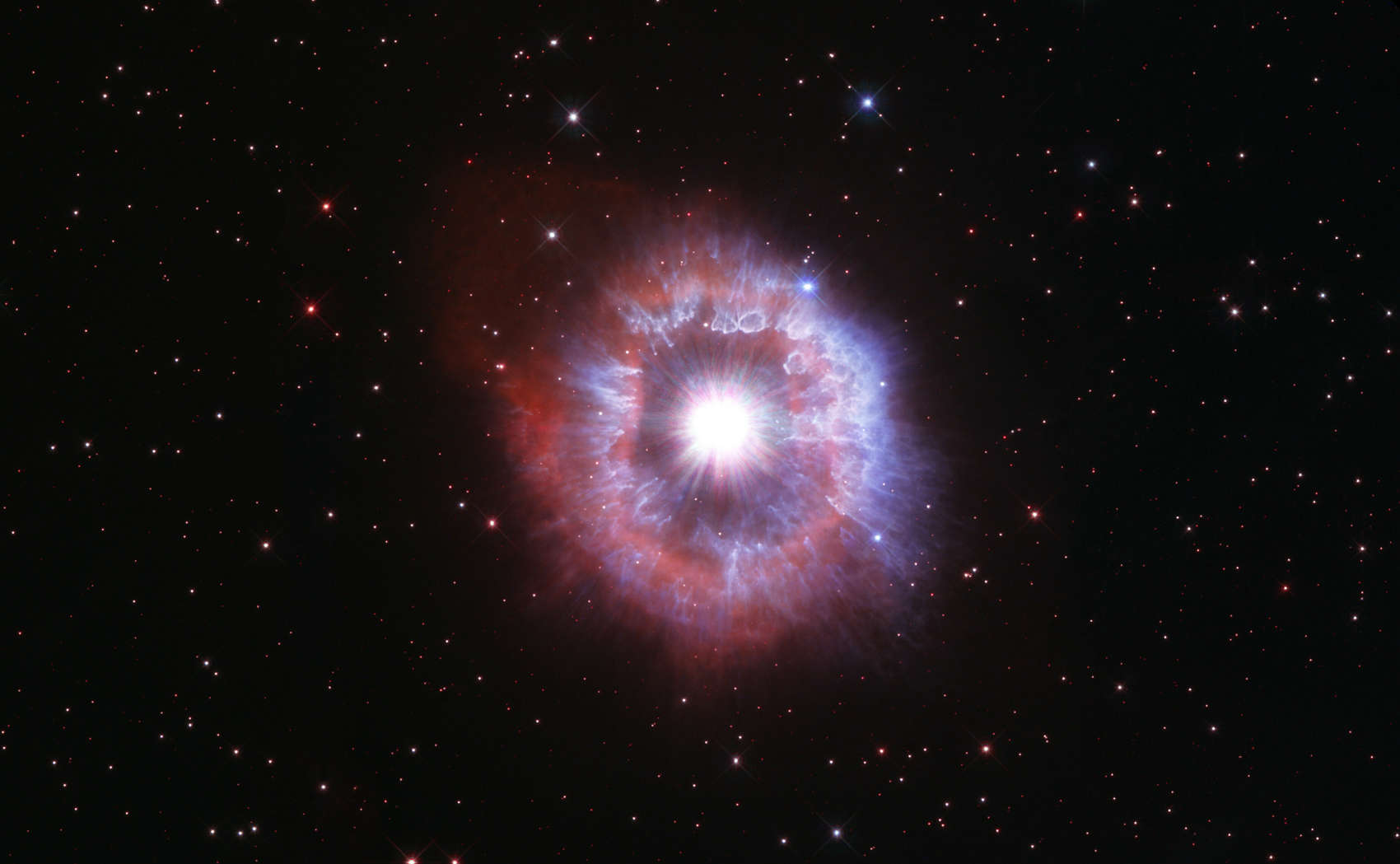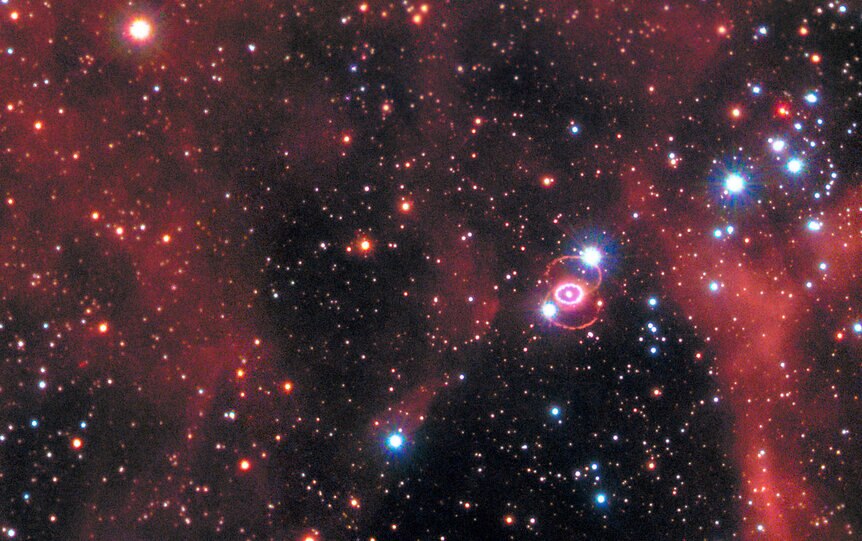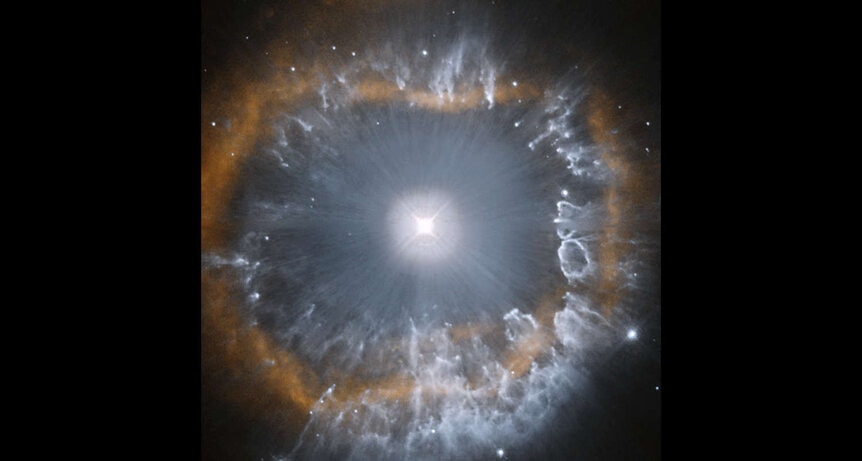Create a free profile to get unlimited access to exclusive videos, sweepstakes, and more!
For its birthday, Hubble has cake with several octillion tons of flaming candles on it

On April 24, 1990, the Space Shuttle orbiter Discovery thundered into orbit. A day later, clamped in the grip of the robotic Canadarm, the Hubble Space Telescope was pulled out of the orbiter's payload bay and then set free to orbit the Earth.
That was 31 years ago this past weekend. Since then, Hubble has looked at everything from the Moon (and even, technically, the Earth) to almost literally the edge of the observable Universe, 13+ billion light years away.
Anticipating the anniversary, earlier this year it was pointed at the absolutely spectacular star AG Carinae, a monster nearing the end of its life. AG Car, as those in know call it, is not going gently into that good night. Oh my no; instead, it's raging quite violently at the dying of its own light.
Yegads. It's beautiful, isn't it? You'd never think this was a star teetering on the thin edge of a catastrophic explosion, periodically blasting off its outer layers in cosmic paroxysms in a desperate effort to maintain its balance.
An effort that is quite doomed.
AG Car is what we call a luminous blue variable, a massive blue star that is soul-puckeringly energetic. Stars fuse lighter elements (like hydrogen) into heavier elements (like helium) in a controlled thermonuclear reaction in their cores. That's where the energy for their light and heat comes from. The rate it fuses those elements — and therefore the energy it produces — scales steeply with the mass.
And AG Car is massive, something like 55 times the mass of the Sun, and it's blasting out a million times the Sun's energy.
One star. A million Suns worth of light.
In fact, it's so luminous that it's unstable. At its surface, an atom of hydrogen, say, feels the quite fierce force of the star's gravity pulling it downward, keeping it attached to the star. But that onslaught of light coming up from the interior tries to push it away, and the two forces are not quite in balance. Complicated events inside the star sometimes make the material more opaque, so it absorbs more energy. This heats the star up, and if things get out of hand, it erupts in an explosion that's just this side of a supernova, sending huge amounts of material careening away at high velocity.
That happened to AG Car in its recent past. A colossal eruption blasted away as much as 15 times the Sun's mass in total — 30 octillion tons — sending it screaming away from the star at speeds up to 100 kilometers per second. The energy of such an event is staggering.
We see that material now as a nebula surrounding the star. Given the diameter of the nebula — about 4 light years, just flipping huge — this eruption must have occurred about 17,000 years ago. Since that time, a fierce wind of subatomic particles from the star has pushed against the nebula, creating a cavity between the star and the gas.
In the Hubble image, blue light represents dust (tiny grains of rocky or literally sooty material) reflecting the star's light. The dust appears clumpy, and a lot of it forms tendrils that point toward the star, shaped by the star's wind and brilliant light pushing on the dust, eroding it.
The red light is from hydrogen gas, and forms a kinked elliptical ring near the nebula's inner edge. At first I thought that might be a snowplow effect: Gas is swept up by the star's wind into a thicker ridge, which makes it brighter. But some studies show this may be a bipolar nebula, shaped like a bowling pin or hourglass (the classic example is the bizarre structure around Supernova 1987A), and we're seeing it nearly pole-on. Nebulae like that tend to have a dense equatorial ring, and that may be what we're actually seeing in the glow of the hydrogen gas.
But why is the ring kinked and not circular? In images taken in 1994, you can see that the hydrogen gas ring is more circular where there's less dust, and bent inward more where there's more dust. As the ring expands it hits that material and slows, giving it that bent shape.
There's some evidence too that the star is rotating incredibly rapidly, with an equatorial speed approaching 100 km/sec! That's so fast it's near breakup speed, where the centrifugal force equals gravity, and the star can literally fling material off its surface. That's very unusual, and unlikely in such a massive star without help. I wonder if it ate a companion star…?
Stars like this fuse hydrogen into helium for a few million years, then expand into red supergiants. There's some evidence AG Car was a supergiant in the past. If so, it would've grown vastly huge, hundreds of millions of kilometers across. If it had a companion star orbiting it, it could have literally engulfed the star, and as the star continued to orbit inside it the material would've been stirred up like batter in a kitchen mixer, speeding the star up. I'm speculating a bit but we've seen things like this happen before. It would also explain how the star was able to eject so much material around it; the phenomenal spin would've made things far easier.
Eventually, AG Car will explode. When it does it may rival Venus in brightness in our night sky! What a sight that would be… though it likely won't happen for hundreds of thousands if not a million or two years. Ah well.
But it's a fitting star for Hubble's anniversary: spectacular, beautiful, awe-inspiring, and also with a couple of dozen solar masses of science to discover.
And 31 years. Holy wow. I was finishing up my Master's degree at the time, and Roger Chevalier, an astronomer I had previously worked with on a small research project, offered me a line of PhD research using Hubble, which at the time was two weeks from launching. I happily accepted, and spent the next few years studying the gas around the above-mentioned Supernova 1987A.
Seeing this image of AG Car is like looking back through a tunnel in time to 1990. There were a lot of ups and downs — Hubble's flawed mirror, waiting months or years between subsequent observations, finally getting my degree and then getting a job working on a Hubble camera — but looking back on it, and examining where I am now… I wouldn't change an electron. I owe a lot to that amazing machine orbiting over our heads, and to the people who designed, built, launched, and used it.
Happy anniversary, Hubble. May you have many, many more orbits ahead of you.





























